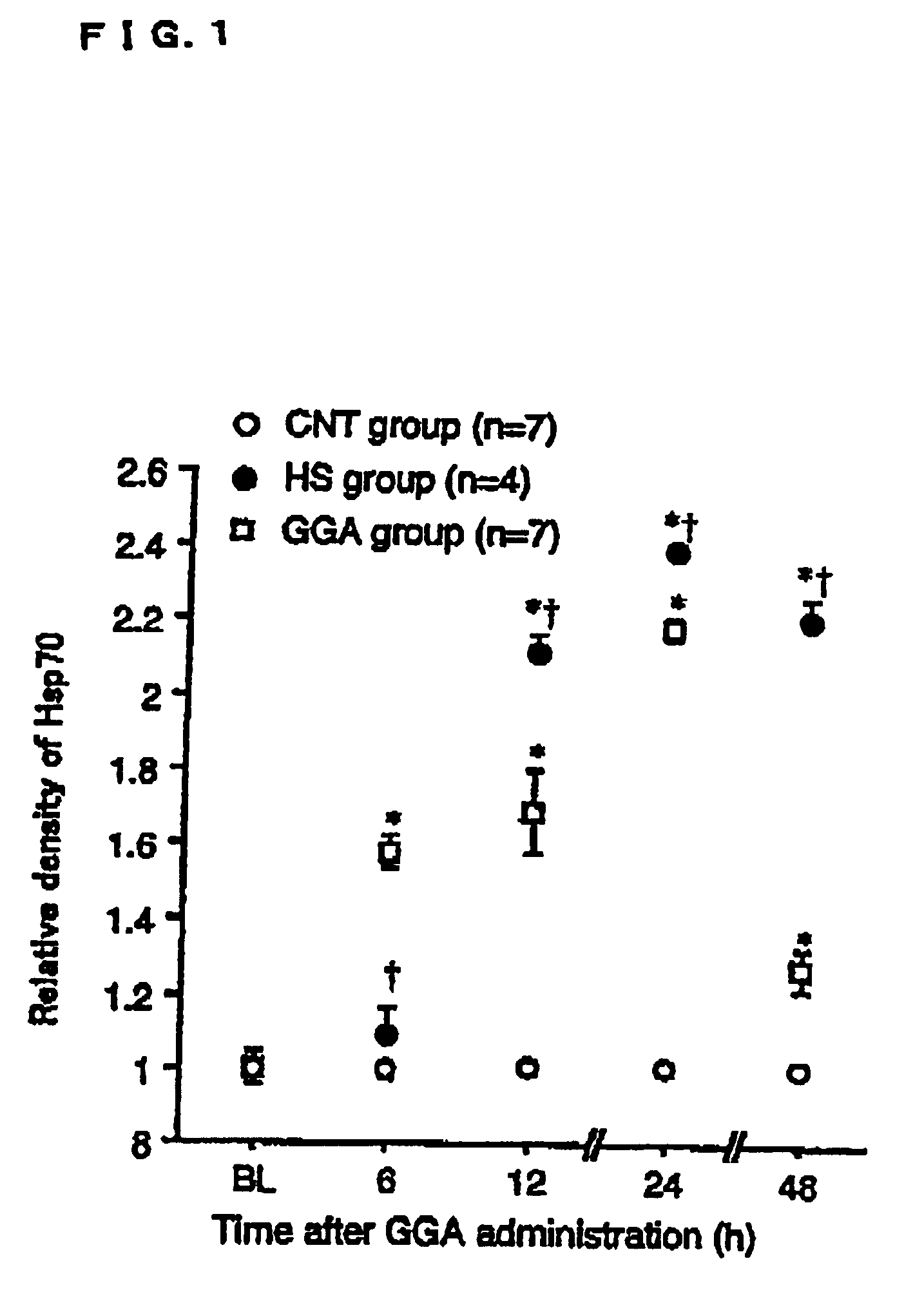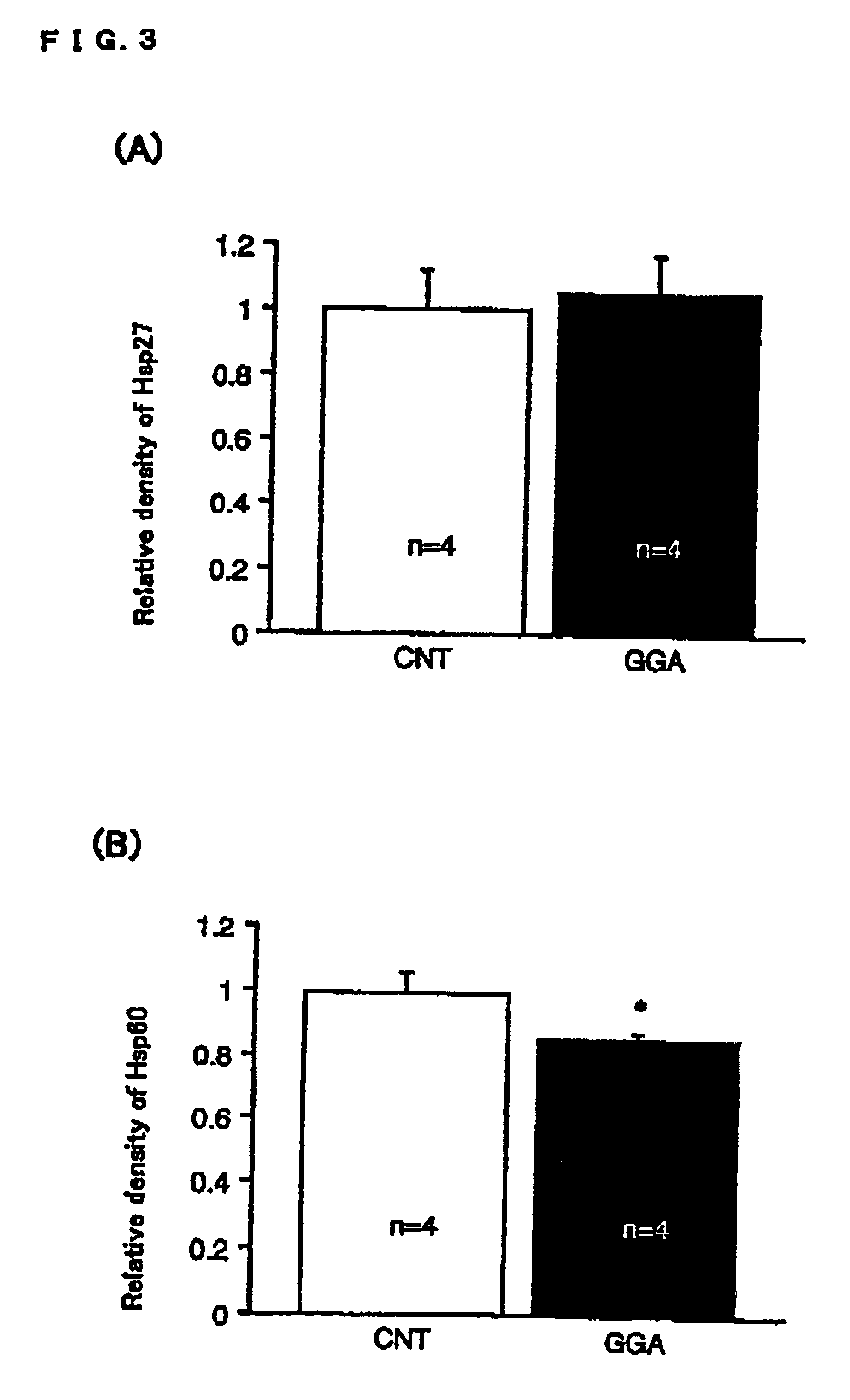Heat shock protein inducer
a protein inducer and heat shock technology, applied in the field of heat shock protein inducers, can solve the problems of depressing cardiac function, reducing blood flow volume, and reducing cardiac function, and achieves the effect of little toxicity and few side effects
- Summary
- Abstract
- Description
- Claims
- Application Information
AI Technical Summary
Benefits of technology
Problems solved by technology
Method used
Image
Examples
example 1
[0053]Materials
[0054]Monoclonal IgG antibody cross-reactive to HSP70, HSP60 and HSP27 antibodies was purchased from Stressgen Biotechnologies Corporation (Sydney, Canada). Primary antibodies of nitric oxide synthase (NOS) or in other words inducible NOS (iNOS), endothelial NOS (eNOS) and neuronal NOS (nNOS) were purchased from Transduction Laboratories (Lexington, Ky.). The primary antibody of thioredoxin was kindly provided by Professor Yodoi of Kyoto University.
[0055]Horseradish peroxidase-linked F(ab′)2 fragment from sheep anti-mouse immunoglobulin and reagents for Western blot detection by enhanced chemiluminescence (ECL) were purchased from Amersham Pharmacia (Arlington, Ill.). Bradford protein assay kits were purchased from Bio-Rad Laboratories (Richmond, Calif.).
[0056]An emulsification of gum arabic by itself was used as the vehicle for administration to the control rats.
[0057]Measuring the Induced Amount of Heat Shock Protein
[0058]Male Sprague-Dawley rats (220-250 g) were an...
example 2
[0086]Materials
[0087]Monoclonal IgG cross-reactive to inducible HSP70 antibody was purchased from Stressgen Biotechnologies Corp. Monoclonal antibodies to PKC-α, -β, -γ, -δ and -ε were purchased from Transduction Laboratories. Horseradish peroxidase-linked F(ab′)2 fragment from sheep anti-mouse immunoglobulin and reagents for Western blot detection by enhanced chemiluminescence (ECL) were purchased from Amersham Pharmacia. Bradford protein assay kits were purchased from Bio-Rad Laboratories. GGA was provided by Eisai Co Ltd.
[0088]Animals
[0089]Male Sprague-Dawley rats (220-250 g) were used. GGA, as an emulsion with 5% gum arabic and 0.008% tocopherol, was given orally at a dose of 200 mg / kg. Rats were classified into 4 groups. FIG. 7 is a diagrammatic representation of experimental protocol. As shown in FIG. 7, 4 groups comprise a control (CNT) group (vehicle administration), a GGA group (GGA 200 mg / kg administration), a CHE-CNT group (pretreated with intravenous injection of 5 mg / kg...
PUM
| Property | Measurement | Unit |
|---|---|---|
| temperature | aaaaa | aaaaa |
| pH | aaaaa | aaaaa |
| left ventricular end diastolic pressure | aaaaa | aaaaa |
Abstract
Description
Claims
Application Information
 Login to View More
Login to View More - R&D
- Intellectual Property
- Life Sciences
- Materials
- Tech Scout
- Unparalleled Data Quality
- Higher Quality Content
- 60% Fewer Hallucinations
Browse by: Latest US Patents, China's latest patents, Technical Efficacy Thesaurus, Application Domain, Technology Topic, Popular Technical Reports.
© 2025 PatSnap. All rights reserved.Legal|Privacy policy|Modern Slavery Act Transparency Statement|Sitemap|About US| Contact US: help@patsnap.com



